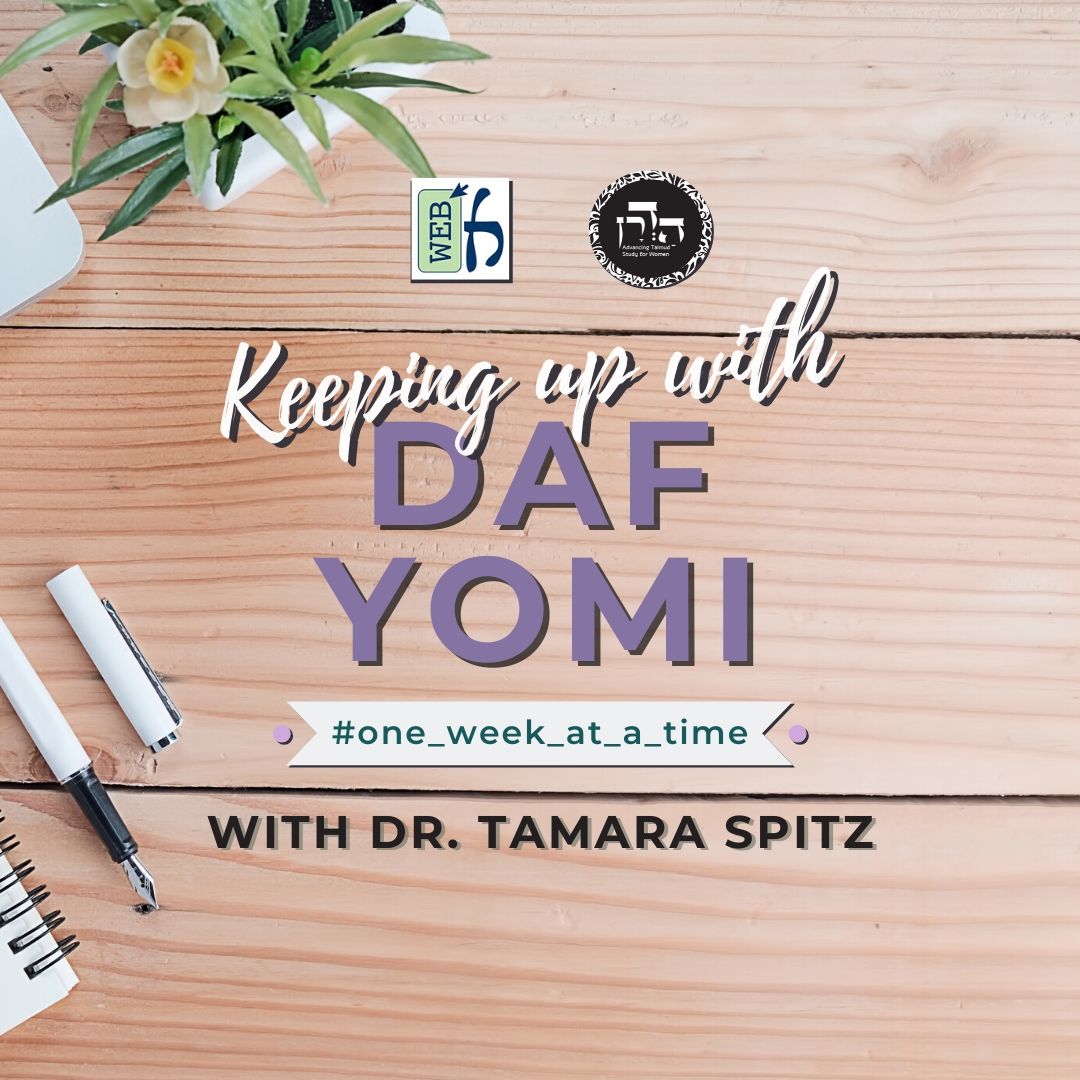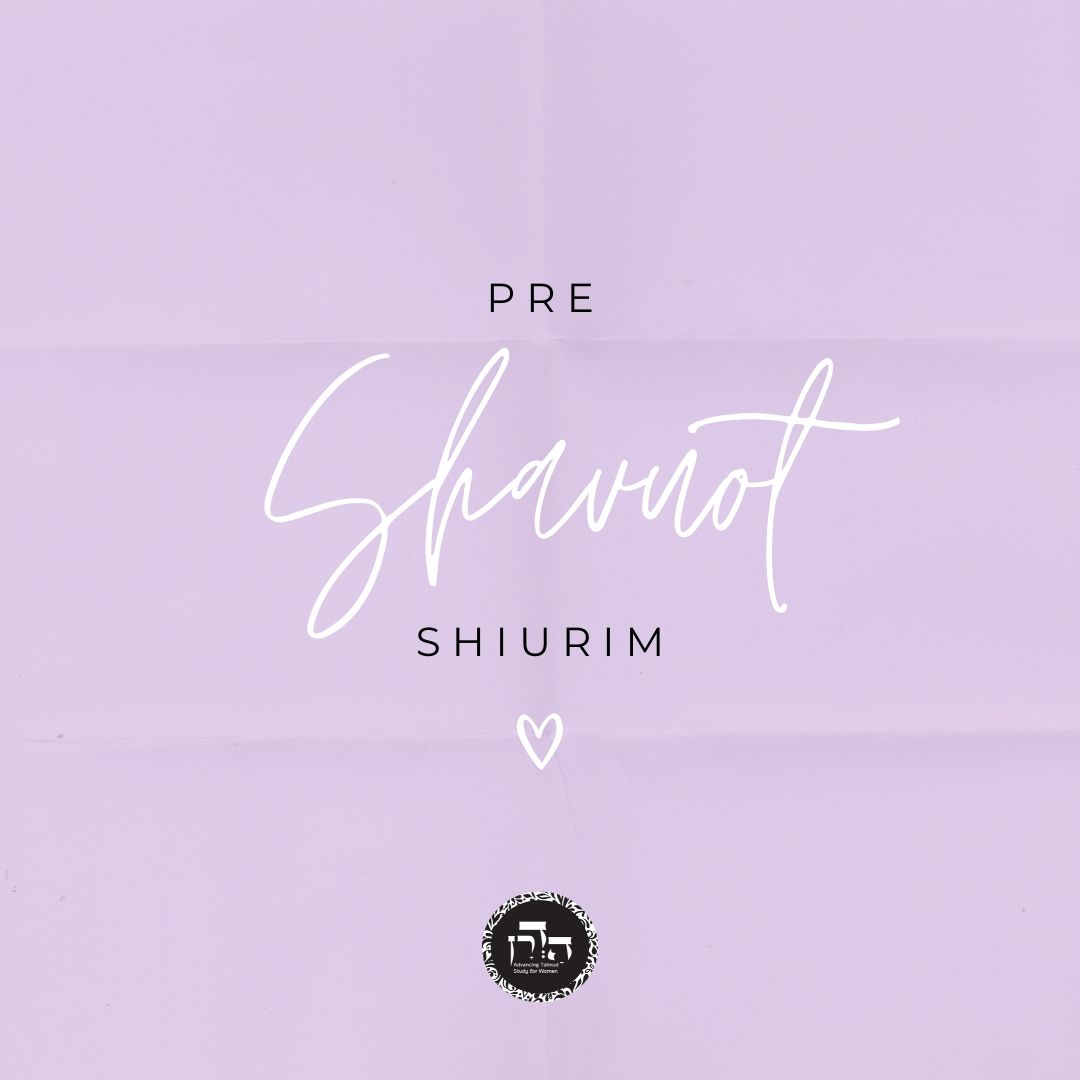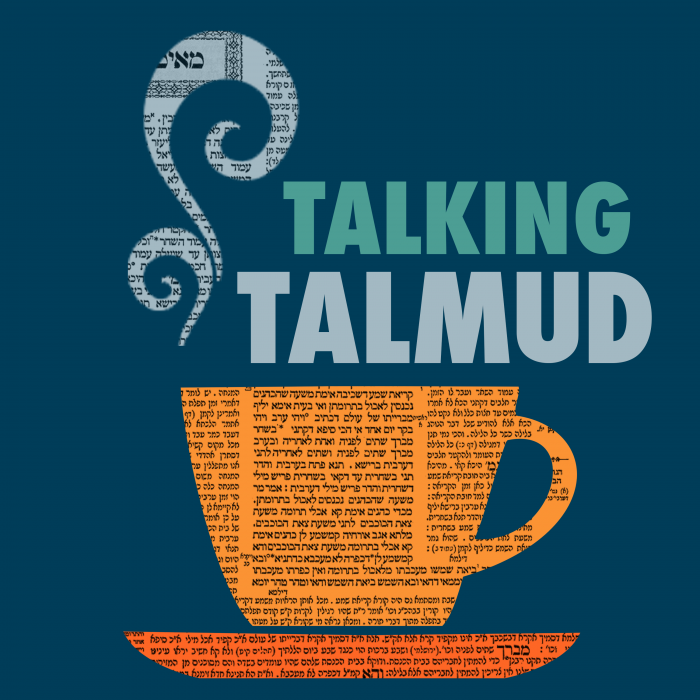Several questions are asked regarding items that have mixed status. What grains are obligated in challa? What grains are permitted by the bringing of the omer?
This week’s learning is sponsored by Audrey Mondrow in memory of Irving “Poppy” Mauskopf, Yechezkel ben Rachel and Avraham. “A man that exemplified complete emuna. He greeted everyone with a smile. We were all very privileged to have him in our lives. May his neshama have an aliya.”
This week’s learning is sponsored by Caroline Bollag l’ilui nishmat Pinchas ben Menashe Peyser.
Want to dedicate learning? Get started here:

Today’s daily daf tools:
This week’s learning is sponsored by Audrey Mondrow in memory of Irving “Poppy” Mauskopf, Yechezkel ben Rachel and Avraham. “A man that exemplified complete emuna. He greeted everyone with a smile. We were all very privileged to have him in our lives. May his neshama have an aliya.”
This week’s learning is sponsored by Caroline Bollag l’ilui nishmat Pinchas ben Menashe Peyser.
Today’s daily daf tools:
Delve Deeper
Broaden your understanding of the topics on this daf with classes and podcasts from top women Talmud scholars.
New to Talmud?
Check out our resources designed to help you navigate a page of Talmud – and study at the pace, level and style that fits you.
The Hadran Women’s Tapestry
Meet the diverse women learning Gemara at Hadran and hear their stories.
Menachot 70
דְּאַמְדִינְהוּ וְעַשְּׂרִינְהוּ וְשַׁתְלִינְהוּ (וְהוֹסִיפָה) [וְאוֹסִיפָא] לְהוּ.
one estimated the amount of tithe necessary, and then he separated those tithes, and then he planted the grain again and it added to its growth. The question is whether we follow the initial growth, and therefore the subsequent growth is exempt from the obligation to separate tithes, or do we follow the additional growth and deem it obligated in tithes?
אִם תִּמְצָא לוֹמַר, לָא אָזְלִינַן בָּתַר עִיקָּר, וְתוֹסֶפֶת בָּעֵי עַשּׂוֹרֵי – עִיקָּר מַאי? אֲמַר לֵיהּ אַבָּיֵי: מַאי שְׁנָא מִכׇּל חִיטֵּי וּשְׂעָרֵי דְּעָלְמָא?
Rabba adds: If you say that we do not follow the main growth and therefore the additional growth requires the separation of tithes, what is the halakha with regard to the main, initial growth? Does it require an additional separation of tithes, or does it not, as tithes were already set aside for it? Abaye said to Rabba: In what way is this case different from any general case of wheat or barley? When grain is tithed and replanted, the obligation of tithes always applies to what then grows.
אֲמַר לֵיהּ: דָּבָר שֶׁזַּרְעוֹ כָּלֶה – לָא מִיבַּעְיָא לִי, אֶלָּא כִּי קָמִיבַּעְיָא לִי – דָּבָר שֶׁאֵין זַרְעוֹ כָּלֶה, מַאי?
Rabba said to Abaye: I do not raise the dilemma with regard to a substance whose seed disintegrates in the ground. In such a case it is clear that the new growth requires a new tithe to be separated, as the original seed is no longer extant. Rather, when I raise the dilemma it is with regard to a substance whose original seed does not disintegrate. What is the halakha? Do we follow the original growth, for which tithes have already been separated, or do we follow the additional growth that is still being generated by that original seed?
תִּפְשׁוֹט לֵיהּ מֵהָא דְּאָמַר רַבִּי יִצְחָק אָמַר רַבִּי יוֹחָנָן: לִיטְרָא בָּצָל שֶׁתִּיקְּנוֹ וּזְרָעוֹ – מִתְעַשֵּׂר לְפִי כּוּלּוֹ.
The Gemara asks: Let him resolve the dilemma from that which Rabbi Yitzḥak said that Rabbi Yoḥanan said: With regard to a litra of onions that one tithed, and then he sowed a field with the entire litra of onions, when the field yields a crop it is tithed according to the entire crop. Although some of the onions he sowed were already tithed, he is obligated to tithe them again because the growths exceed the original onions and therefore the entire crop has untithed status.
הָתָם – הַיְינוּ זְרִיעָתוֹ, הָכָא – לָאו הַיְינוּ זְרִיעָתוֹ.
The Gemara rejects that resolution: There, in the case of the field sowed with the tithed onions, the entire field must be tithed because that is the normal way in which a field is sowed. One generally replants a full onion, and therefore the focus is not on the original onion but on the yield, which must be fully tithed. Here, in the case of grain, this is not the normal way in which a field is sowed. Generally one plants individual kernels, not fully grown ears of grain. Consequently, any subsequent growth from that fully grown ear is considered part of the original growth.
אֲמַר לֵיהּ רַבִּי חֲנִינָא בַּר מִנְיוֹמֵי לְאַבָּיֵי: עָצִיץ שֶׁאֵינוֹ נָקוּב, מַהוּ? אִי לֹא נָקוּב – הָא לֹא נָקוּב!
Rabbi Ḥanina bar Minyumi said to Abaye: In a case of a flowerpot [atzitz] that is not perforated, what is the halakha with regard to separating teruma and tithes? Abaye replied: What is the difficulty here? If it is not perforated, this halakha is the same as that of any non-perforated flowerpot, i.e., the separation of teruma and tithes is required by rabbinic law.
דִּלְמָא חָזַר וּנְקָבוֹ, קָא אָמְרַתְּ?
Abaye continues: Perhaps what you meant to say is that he subsequently went and perforated it. In such a case the question is whether one may separate teruma and tithes from the initial growth of the plant. Is the initial growth considered a separate entity, in which case one part of the growth requires the separation of teruma and tithes by rabbinic law and the rest by Torah law, and therefore one may not separate from the initial growth? Alternatively, perhaps the initial growth is nullified by the subsequent growth, which would mean that the obligation of teruma and tithes applies to the entire plant by Torah law. Consequently, this obligation can be fulfilled by separating teruma and tithes from the initial growth of the plant. This would be similar to Rabba’s dilemma with regard to an ear of grain that is replanted.
הָכָא, חֲדָא זְרִיעָה הִיא, אִיחַבּוֹרֵי הוּא דְּקָא מִיחַבְּרָא וְעוֹלָה; הָתָם – שְׁתֵּי זְרִיעוֹת נִינְהוּ.
Abaye explains that the two cases are not comparable. Here, in the case of the non-perforated flowerpot which was subsequently perforated, it is one single sowing. Therefore, although the original growth occurred while the pot was not perforated, since it is now perforated, the plant is considered attached to the ground and it rises and grows from there. Consequently, the obligation of teruma and tithes applies to the entire plant by Torah law. There, in Rabba’s dilemma involving the replanting of an ear of grain, there are two distinct sowings. Therefore, there is room to debate whether or not the additional, second sowing is part of the original, first sowing.
בָּעֵי רַבִּי אֲבָהוּ: שִׁבּוֹלֶת שֶׁמֵּרְחָהּ בִּכְרִי, וּשְׁתָלָהּ, וְקָרָא עָלֶיהָ שֵׁם בִּמְחוּבָּר – מַהוּ? כֵּיוָן דְּמֵרְחָהּ טָבְלָא לַהּ, כִּי קָרָא עָלֶיהָ שֵׁם קָדְשָׁה לַהּ, אוֹ דִלְמָא, כֵּיוָן דְּשַׁתְלַהּ – פְּקַע לֵיהּ טִבְלָא מִינַּהּ.
§ Rabbi Abbahu raises a dilemma: With regard to an ear of grain that one smoothed into a pile and then sowed it again and subsequently designated it as teruma or tithes while it was attached to the ground, what is the halakha? Does one say that since he smoothed it, which is the act that renders produce subject to the obligation of teruma and tithes, he has given it the status of untithed produce, and therefore when he subsequently designated it he thereby sanctified it? Or perhaps, since he had sowed it again after he had smoothed it, its status as untithed produce lapsed from it.
אָמְרִי לֵיהּ רַבָּנַן לְאַבָּיֵי: אִם כֵּן, מָצִינוּ תְּרוּמָה בִּמְחוּבָּר לַקַּרְקַע, וּתְנַן: לֹא מָצִינוּ תְּרוּמָה בִּמְחוּבָּר לַקַּרְקַע!
The Sages said to Abaye: If so, that the grain is sanctified in this situation, we have found a case of teruma that is sanctified while it is still attached to the ground. But we learn in a baraita: We do not find a case of teruma attached to the ground. Therefore, one must conclude that its status as untithed produce has been removed, and his designation does not render it teruma.
אֲמַר לֵיהּ: כִּי תַּנְיָא הָהִיא – לְעִנְיַן אִיחַיּוֹבֵי מִיתָה וָחוֹמֶשׁ, דְּאִי תָּלֵישׁ וְאָכֵיל – תָּלוּשׁ הוּא, וְאִי גָּחֵין וְאָכֵיל – בָּטְלָה דַּעְתּוֹ אֵצֶל כׇּל אָדָם.
Abaye said to one of those Sages: When that baraita is taught, it is taught with regard to teruma, which renders a non-priest liable to death at the hand of Heaven or payment of a fifth. If a non-priest ate teruma intentionally he is liable to receive death at the hand of Heaven; if he ate it unintentionally, he must restore the amount he ate with the addition of one-fifth (see Leviticus 22:9, 14). The reason there is no penalty for eating teruma that is attached to the ground is that if one detaches it and eats it, it is considered detached. And if he stooped down and ate it while it was attached to the ground he is not liable, as his intention is rendered irrelevant by the opinions of all other people. In other words, this is an abnormal manner of eating, for which one is not liable.
וּמַאי שְׁנָא מִדִּכְתַב אַפִּינַקְסָא דְּאִילְפָא: בֵּיצֵי נִבְלַת הָעוֹף הַטָּהוֹר, מִקְצָתָן בַּחוּץ וּמִקְצָתָן בִּפְנִים – מִבִּפְנִים מְטַמְּאִין בְּגָדִים אַבֵּית הַבְּלִיעָה, מִבַּחוּץ אֵין מְטַמְּאִין בְּגָדִים אַבֵּית הַבְּלִיעָה.
The Gemara asks: In what way is this case different from the halakha that is written on the tablet [appinkesa] of Ilfa: With regard to eggs found with the carcass of a kosher bird, some of them outside the bird and some of them inside the bird, if one ate from those inner eggs directly from inside the bird, they render the garments of one who swallows them ritually impure when they are in the throat. If he removed those same eggs and ate from them when they were outside the bird, they do not render the garments of one who swallows them ritually impure when they are in the throat. Apparently, even the abnormal method of eating eggs while they are inside the bird is still considered eating. If so, the same should apply to consuming teruma abnormally by stooping down and eating it while it is still attached to the ground.
תָּלוּשׁ – עֲבִידִי אִינָשֵׁי דְּאָכְלִי הָכִי, בִּמְחוּבָּר – לָא עֲבִידִי אִינָשֵׁי דְּאָכְלִי.
The Gemara answers: With regard to an item that is detached, i.e., the eggs inside the bird, it is relatively common for people to eat even in this manner. But with regard to an item that is attached to the ground, it is not common for people to eat such produce at all.
אָמַר רַב טָבְיוֹמֵי בַּר קִיסְנָא, אָמַר שְׁמוּאֵל: הַזּוֹרֵעַ כִּלְאַיִם בְּעָצִיץ שֶׁאֵינוֹ נָקוּב – אָסוּר. אָמַר אַבָּיֵי: בִּשְׁלָמָא אִי אַשְׁמְעִינַן לוֹקֶה מַכַּת מַרְדּוּת מִדְּרַבָּנַן – שַׁפִּיר, אֶלָּא אָסוּר – מַאי קָא מַשְׁמַע לַן?
§ Rav Tavyumei bar Kisna says that Shmuel says: With regard to one who plants diverse kinds of plants in a non-perforated flowerpot, this is prohibited. Abaye said: What is novel about this halakha? Granted if Shmuel had taught us that one who plants in this manner is flogged with lashes for rebelliousness by rabbinic law, it is well and understandable. But with this basic ruling he stated, that it is prohibited, what is he teaching us?
דְּמִדְּרַבָּנַן הָוְיָא זְרִיעָה? תְּנֵינָא: תָּרַם מִשֶּׁאֵינוֹ נָקוּב עַל הַנָּקוּב – תְּרוּמָה, וְיַחְזוֹר וְיִתְרוֹם.
Is he teaching that planting in a non-perforated flowerpot is considered sowing by rabbinic law? We already learn this in a mishna (Demai 5:10): If one separated teruma from produce grown in a non-perforated pot for produce of a perforated pot, it is teruma by rabbinic law, and he must again separate teruma from the produce obligated in teruma by Torah law to render the produce grown in the perforated pot permitted in consumption. Since this separation has the status of teruma by rabbinic law, evidently sowing in a non-perforated pot is considered sowing.
מַתְנִי׳ הַחִיטִּין, וְהַשְּׂעוֹרִין, וְהַכּוּסְּמִין, וְהַשִּׁיבּוֹלֶת שׁוּעָל, וְהַשִּׁיפוֹן – הֲרֵי אֵלּוּ חַיָּיבִין בַּחַלָּה, וּמִצְטָרְפִין זֶה עִם זֶה, וַאֲסוּרִים בֶּחָדָשׁ מִלִּפְנֵי הַפֶּסַח, וּמִלִּקְצוֹר מִלִּפְנֵי הָעוֹמֶר. אִם הִשְׁרִישׁוּ קוֹדֶם לָעוֹמֶר – הָעוֹמֶר מַתִּירָן, וְאִם לָאו – אֲסוּרִין עַד שֶׁיָּבֹא הָעוֹמֶר הַבָּא.
MISHNA: Wheat, barley, spelt, oats, and rye; these are obligated in the separation of ḥalla, and each one of them joins together with the othersto constitute the measure that obligates one to separate ḥalla. And they are prohibited due to the prohibition of partaking of the new crop prior to the Passover Festival, and likewise it is prohibited to reap them prior to the omer offering. If these grains took root prior the omer offering, the omer permits their consumption; and if not, they are prohibited until the next omer is brought and sacrificed the following year.
גְּמָ׳ תָּנָא: כּוּסְּמִין – מִין חִיטִּים, שִׁיבּוֹלֶת שׁוּעָל וְשִׁיפוֹן – מִין שְׂעוֹרִין. כּוּסְּמִין –
GEMARA: The Gemara discusses the identity of the species mentioned in the mishna. A Sage taught in a baraita: Spelt is a type of wheat, while oats and rye are a type of barley. The Gemara translates the lesser-known species into the vernacular Aramaic: Spelt is called
גּוּלְבָּא, שִׁיפוֹן – דִּישְׁרָא, שִׁיבּוֹלֶת שׁוּעָל – שֻׁבְלֵי תַּעֲלָא. הָנֵי – אִין, אוֹרֶז וְדוֹחַן – לָא.
gulva, rye is dishra, and oats are shibbolei ta’ala. The Gemara infers: With regard to these species, yes, the obligation of ḥalla applies to them, but concerning rice and millet, no, the obligation of ḥalla does not apply to them.
מְנָא הָנֵי מִילֵּי? אָמַר רֵישׁ לָקִישׁ: אָתְיָא ״לֶחֶם״ ״לֶחֶם״ מִמַּצָּה. כְּתִיב הָכָא: ״וְהָיָה בַּאֲכׇלְכֶם מִלֶּחֶם הָאָרֶץ״, וּכְתִיב הָתָם: ״לֶחֶם עֹנִי״.
The Gemara asks: From where is this matter, that only these five grains are obligated in the separations of ḥalla, derived? Reish Lakish said: This principle is derived by means of a verbal analogy between “bread” and “bread” from the case of matza. It is written here, with regard to ḥalla: “And it shall be that when you eat of the bread of the land, you shall set apart a portion for a gift to the Lord” (Numbers 15:19), and it is written there, with regard to matza: “Bread of affliction” (Deuteronomy 16:3). Just as matza can be prepared only from one of those five grains, so too the obligation of ḥalla applies only to bread from one of those five grains.
וְהָתָם גּוּפַהּ מְנָלַן? אָמַר רֵישׁ לָקִישׁ, וְכֵן תָּנָא דְּבֵי רַבִּי יִשְׁמָעֵאל, וְכֵן תָּנָא דְּבֵי רַבִּי אֱלִיעֶזֶר בֶּן יַעֲקֹב: אָמַר קְרָא ״לֹא תֹאכַל עָלָיו חָמֵץ שִׁבְעַת יָמִים תֹּאכַל עָלָיו מַצּוֹת לֶחֶם עֹנִי״ – דְּבָרִים הַבָּאִים לִידֵי חִימּוּץ אָדָם יוֹצֵא בָּהֶן יְדֵי חוֹבָתוֹ בַּפֶּסַח, יָצְאוּ אֵלּוּ שֶׁאֵין בָּאִין לִידֵי חִימּוּץ אֶלָּא לִידֵי סֵירָחוֹן.
The Gemara asks: And there, with regard to matza itself, from where do we derive that it must be from one of those five grains? The Gemara answers: Reish Lakish said, and likewise a Sage of the school of Rabbi Yishmael taught, and likewise a Sage of the school of Rabbi Eliezer ben Ya’akov taught, that the verse states: “You shall eat no leavened bread with it; seven days you shall eat with it matza, the bread of affliction” (Deuteronomy 16:3). This verse indicates that only with regard to substances that will come to a state of leavening does a person fulfill his obligation to eat matza by eating them on Passover, provided that he prevents them from becoming leavened. This serves to exclude these foods, i.e., rice, millet, and similar grains, which, even if flour is prepared from them and water is added to their flour, do not come to a state of leavening but to a state of decay [sirḥon].
וּמִצְטָרְפִין זֶה עִם זֶה. תָּנָא: הַתְּבוּאָה וְהַקְּמָחִים וְהַבְּצֵיקוֹת מִצְטָרְפִין זֶה עִם זֶה. לְמַאי הִלְכְתָא?
§ The mishna teaches that each one of the five types of grain joins together with the others to constitute the measure that obligates one to separate ḥalla. It was taught in a baraita: With regard to grain from produce and flours and pieces of dough, each one of these joins together with the others. The Gemara asks: With regard to what halakha was this taught?
אָמַר רַב כָּהֲנָא: לְעִנְיַן חָדָשׁ. רַב יוֹסֵף אָמַר: לְעִנְיַן חָמֵץ בַּפֶּסַח. רַב פָּפָּא אָמַר: לְעִנְיַן מַעֲשֵׂר שֵׁנִי, דְּאִי אָכֵיל לֵיהּ חוּץ לַחוֹמָה – לָקֵי.
Rav Kahana says: It was taught with regard to the prohibition of eating of the new crop prior to the sacrifice of the omer offering on the sixteenth of Nisan. If one ate grain, flour, and dough of the new crop that combined to equal the size of an olive-bulk, he is liable to receive lashes for transgressing a prohibition. Rav Yosef says: It was taught with regard to the prohibition of eating leavened bread on Passover. Rav Pappa says: It was taught with regard to the prohibition of eating second tithe outside the walls of Jerusalem. As, if one ate a combined olive-bulk’s worth of grain, flour and dough of the second tithe outside the wall of Jerusalem, he is flogged.
רָבָא אָמַר: לְעִנְיַן טוּמְאַת אֳכָלִין, וְהָא קָא מַשְׁמַע לַן: דִּתְבוּאָה וּקְמָחִין דּוּמְיָא דִּבְצֵקוֹת – מָה הָתָם אוּכְלָא בְּעֵינֵיהּ, אַף הָכָא נָמֵי אוּכְלָא בְּעֵינֵיהּ.
Rava says: The baraita is referring to the matter of the ritual impurity of food; and this is what it teaches us: That grains of barley produce and flours are similar to pieces of dough. Just as there, concerning pieces of dough, they combine to form the minimal measure of ritually impure food only if the combination of food is as is, without other additives, so too here also, concerning grain and flour, they combine to form the minimal measure of ritually impure food only when the mixture is food as is, without any shell or other additives.
וְהָתַנְיָא: חִטָּה, בֵּין קְלוּפָה בֵּין שֶׁאֵינָהּ קְלוּפָה – מִצְטָרֶפֶת; שְׂעוֹרָה, קְלוּפָה – מִצְטָרֶפֶת, שֶׁאֵינָהּ קְלוּפָה – אֵין מִצְטָרֶפֶת.
The Gemara cites support for this opinion, as it is taught in a baraita: Wheat, whether shelled or unshelled, combines to form the minimal measure of food that is susceptible to ritual impurity. But as for barley, it combines only when it is shelled. When it is not shelled, it does not combine together, as the inedible shell interposes between the different grains. This support Rava’s interpretation of the baraita, that it addresses barley in the form of grain, flour, and dough.
אִינִי? וְהָא תָּנָא דְּבֵי רַבִּי יִשְׁמָעֵאל: ״עַל כׇּל זֶרַע זֵרוּעַ אֲשֶׁר יִזָּרֵעַ״ – כְּדֶרֶךְ שֶׁבְּנֵי אָדָם מוֹצִיאִין לִזְרִיעָה: חִטָּה בִּקְלִיפָּתָהּ, וּשְׂעוֹרָה בִּקְלִיפָּתָהּ, וַעֲדָשִׁים בִּקְלִיפָּתָן.
The Gemara asks: Is that so, that the shell of barley is not considered part of the grain with regard to combining for ritual impurity? But didn’t the school of Rabbi Yishmael teach in a baraita: Before a food item comes in contact with liquid it is not susceptible to ritual impurity, as the verse states: “And if anything falls from their carcasses upon any sowing seed that is sown, it is pure. But if water be put upon the seed, and any of the carcass fall thereon, it is impure unto you” (Leviticus 11:37–38). The baraita teaches that the term “that is sown” indicates that the entire seed is susceptible to ritual impurity when it is in a state where it is typical for people to take it out to the field for sowing. This applies to wheat in its shell, barley in its shell, and lentils in their shells. This demonstrates that shells are considered part of the grain with regard to ritual impurity.
לָא קַשְׁיָא, הָא בְּלַחוֹת, הָא בִּיבֵשׁוֹת.
The Gemara answers: It is not difficult. The ruling of this baraita, which teaches that the shells of kernels are considered part of it with regard to ritual impurity, is stated with regard to moist kernels, whereas the ruling of that baraita, which teaches that the shells are not part of the seed, is stated with regard to dry kernels, in which the shells crumble and fall away.
וַאֲסוּרִין בֶּחָדָשׁ מִלִּפְנֵי הַפֶּסַח, מְנָא הָנֵי מִילֵּי? אָמַר רֵישׁ לָקִישׁ: אָתְיָא ״לֶחֶם״ ״לֶחֶם״ מִמַּצָּה.
§ The mishna teaches with regard to the five grains: And they are forbidden due to the prohibition of partaking of the new crop prior to the Passover festival. The Gemara asks: From where is this matter derived? Reish Lakish said: It is derived by means of a verbal analogy between “bread” written in connection with the prohibition of the new crop (see Leviticus 23:14), and “bread” written with regard to matza (see Deuteronomy 16:3). Just as matza can be prepared only from one of the five grains, so too the prohibition against eating of the new crop applies only to the five grains.
וְלִקְצוֹר לִפְנֵי הָעוֹמֶר, מְנָא הָנֵי מִילֵּי? אָמַר רַבִּי יוֹחָנָן: אָתְיָא ״רֵאשִׁית״ ״רֵאשִׁית״ מֵחַלָּה.
§ The mishna further teaches with regard to the five grains: And it is prohibited to reap them prior to the omer offering. The Gemara asks: From where are these matters derived? Rabbi Yoḥanan said: It is derived by means of a verbal analogy between “the first” written in conjunction with the new crop: “You shall bring the sheaf of the first fruits of your harvest to the priest” (Leviticus 23:10), and “the first” written with regard to ḥalla: “Of the first of your dough you shall set apart a cake for a gift” (Numbers 15:20). Just as the obligation to separate ḥalla applies only to bread prepared from the five grains, so too the prohibition against reaping the new crop prior to the omer offering applies only to crops of the five grains.
מַאי קוֹדֶם לָעוֹמֶר? רַבִּי יוֹנָה אָמַר: קוֹדֶם קְצִירַת הָעוֹמֶר, רַבִּי יוֹסֵי בַּר זַבְדָּא אָמַר: קוֹדֶם הֲבָאַת הָעוֹמֶר.
The Gemara asks: What does the mishna mean when it says: Prior to the omer? Does it mean prior to the reaping of the omer grain or prior to the sacrifice of the omer offering? Rabbi Yona says: It means prior to the reaping of the omer grain, i.e., the new crop is permitted at daybreak on the sixteenth of Nisan. Rabbi Yosei bar Zavda says: Prior to the bringing of the omer offering later that day.
תְּנַן: אֲסוּרִין בֶּחָדָשׁ לִפְנֵי פֶסַח, וְלִקְצוֹר לִפְנֵי הָעוֹמֶר. בִּשְׁלָמָא לְמַאן דְּאָמַר קוֹדֶם הֲבָאַת הָעוֹמֶר – הַיְינוּ דְּלָא קָא עָרֵיב לְהוּ וְתָנֵי לְהוּ.
The Gemara cites a proof from that which we learned in the mishna: And they are forbidden due to the prohibition of partaking of the new crop prior to the Passover Festival, and likewise it is prohibited to reap them prior to the sacrifice of the omer offering. Granted, according to the one who said that the prohibition applies prior to the bringing of the omer offering, this is the reason that the mishna did not combine the clauses together and teach them as one, since the time frame for each prohibition is different. The prohibition of harvesting the new crop is lifted at daybreak after the omer crop was harvested at night, whereas the prohibition against consuming the new crop ends only with the sacrifice of the omer offering later that day.
אֶלָּא לְמַאן דְּאָמַר קוֹדֶם קְצִירַת הָעוֹמֶר, לִיעָרְבִינְהוּ וְלִיתְנִינְהוּ: אֲסוּרִין בֶּחָדָשׁ וְלִקְצוֹר לִפְנֵי הַפֶּסַח!
But according to the one who said that the prohibition applies prior to the reaping of the omer grain, then both the consuming and the harvesting of the new crop are permitted at daybreak of the sixteenth of Nisan. If so, let the mishna combine them and teach them together, as follows: And they are forbidden due to the prohibition of partaking of the new crop, and likewise it is prohibited to reap them prior to the Passover Festival.
אֶלָּא, אִי אִיתְּמַר – אַסֵּיפָא אִיתְּמַר: אִם הִשְׁרִישׁוּ קוֹדֶם לָעוֹמֶר – הָעוֹמֶר מַתִּירָן. מַאי קוֹדֶם לָעוֹמֶר? רַבִּי יוֹנָה אָמַר: קוֹדֶם הֲבָאַת הָעוֹמֶר, רַבִּי יוֹסֵי בַּר זַבְדָּא אוֹמֵר: קוֹדֶם קְצִירַת הָעוֹמֶר.
The Gemara answers: Rather, if a dispute was stated in this matter, it was stated with regard to the latter clause of the mishna, which teaches: If these grains took root prior to the omer offering, the omer permits their consumption. What does the mishna mean when it says: Prior to the omer? Rabbi Yona says: Prior to the bringing of the omer sacrifice. Rabbi Yosei bar Zavda says: Prior to the harvesting of the omer grain.
אֲמַר לֵיהּ רַבִּי אֶלְעָזָר
Rabbi Elazar said to







































